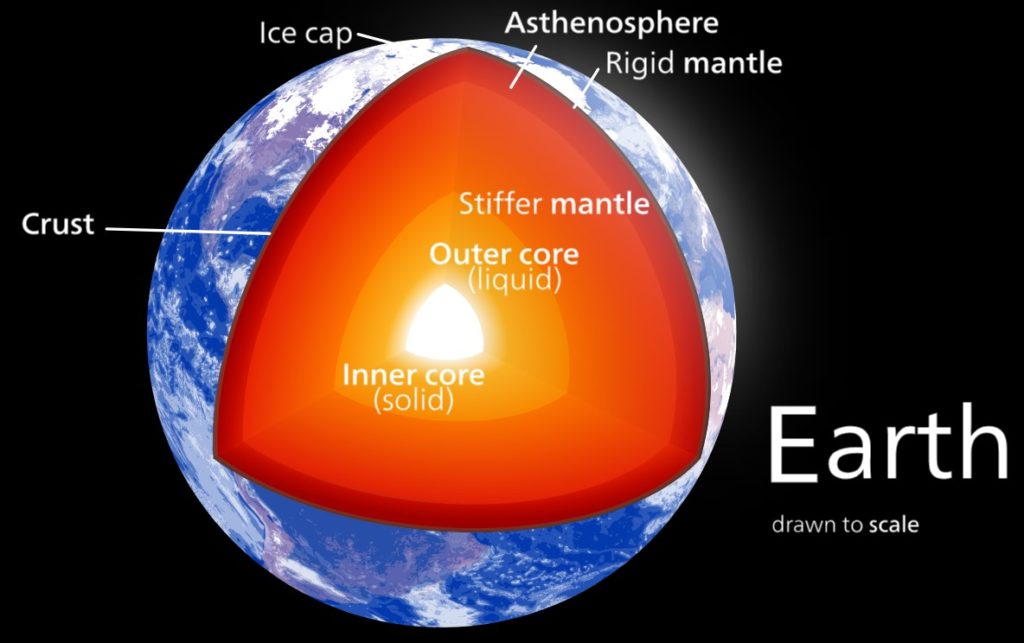
How can the inner core of the Earth switch rotation? Because it is separated from the solid mantle and can rotate at a different speed.
The Earth has four layers. There is the outer crust that we and everything alive lives on. The crust is about 40 km deep and is only 1% of Earth’s mass. Underneath the crust is the second layer, the mantle. The mantle is made of mostly solid rocks and minerals, and is about 2,900 km thick. It contains 84% of the Earth’s mass. The mantle is often pictured as a large ball of liquid magma that the tectonic plates in the crust float on, but it is not a liquid. It was, when the Earth was formed, but it solidified as the Earth cooled. Now, it is more easily described as a ball of malleable rock. In some places, the mantle is completely solid, and in other places, where the heat and pressure are much higher, it is completely liquid, but in most areas it is made up of soft, plastic rocks. The temperature of the mantle can range from about 227 ˚C at the edge of the crust, down to 3,900 ˚C at the boundary with the core.
The third layer is the outer core. The outer core is about 2,200 km thick and it comprises about 29.3% of the Earth’s mass. It is made of molten iron and nickel, and it is about 4,000 ˚C at the outer edge and 5,500 ˚C at the inner edge. The extremely high pressure of the Earth pressing down on the outer core keeps the temperature high and keeps the iron and nickel in a molten state. Then we have the fourth layer, the inner core. The inner core is about 2,414 km thick and consists of about 1.7% of the Earth’s mass. It is made of mostly iron, with some nickel, and has temperatures of over 5,500 ˚C. However, despite the heat, the inner core is solid.
How can the inner core be solid when the temperature is higher than the surface of the sun? It is to do with the pressure. The inner core is under more pressure than any other part of the Earth and the melting point, or boiling point, of materials increases the more pressure there is. For example, water boils at 100 ˚C at sea level where the pressure is one atmosphere. It boils at 68 ˚C on the top of Mt Everest, where the pressure is about 0.3 atmospheres, and it would boil at 400 ˚C at the bottom of the Mariana Trench, where the pressure is 1,000 atmospheres. This fact keeps the core of the planet solid. The pressure at the center of the Earth is 3.6 million atmospheres. Iron melts at 1,538 ˚C at sea level, but it melts at over 6,000 ˚C under the pressure of the inner core, a temperature that the inner core doesn’t exceed.
How does the inner core spin? When the Earth spins, the crust, mantle, and outer core have to rotate with it. The inner core is separated by the outer core, which gives it a fluid surface to float on. The inner core can rotate independently to the rest of the planet. It is powered in almost the same way as a motor that spins. Convection currents in the outer layer flow east to west, giving the core a spin and the rotating iron core and the outer core also create a magnetic field which adds to the spin.
There is no way of viewing or measuring the inner core because we cannot get to it. Theories about its physical state and properties have been drawn up by analyzing the way seismic waves from earthquakes travel through the planet. A sound wave travels at a different speed through a liquid and a solid, so by analyzing the length of time that the seismic wave took to reach the other side of the planet, it was possible to say that the center of the planet was most likely solid. It is then possible to look at these results over time and say how fast the inner core is rotating.
Scientists have discovered that since the 1960s, the rotation of the core has slowed down and reversed. They think that the direction reverses every seventy years. The theory is that there is a slight imbalance in the electromagnetic field which is enough to slow and reverse the core’s rotation. Some people think it could be as often as every 30 years and one scientist says every 6 years. It sounds pretty scary if the inner core reverses its direction, but it doesn’t have any effect on anything. It will shorten the length of a day by a fraction of a millisecond and it may have a small effect on the magnetic field, but that is it.
So, the inner core is a solid iron ball that rotates in the liquid outer core. It powers itself with a magnetic field and an imbalance in that field means that it shifts direction every now and again. And this is what I learned today.
https://www.lpi.usra.edu/education/explore/ice/background/allAboutWater/
https://pubmed.ncbi.nlm.nih.gov/23620049/
https://scienceline.ucsb.edu/getkey.php?key=5
https://en.wikipedia.org/wiki/Earth%27s_mantle
https://en.wikipedia.org/wiki/Earth%27s_inner_core
https://en.wikipedia.org/wiki/Earth%27s_outer_core
https://www.calacademy.org/explore-science/from-core-to-crust-defining-earths-layers
https://education.nationalgeographic.org/resource/crust/
https://www.calacademy.org/explore-science/from-core-to-crust-defining-earths-layers
https://education.nationalgeographic.org/resource/core/
